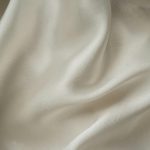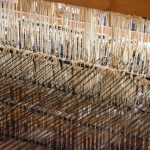If you rely on para-aramid fabric, you benefit from fibers that are unusually strong and heat resistant thanks to tightly aligned molecular chains forming strong hydrogen bonds. This fabric doesn’t melt but chars at high heat, keeping you protected. It’s made by spinning and drawing polymer chains into tough, durable fibers used in gear from firefighting to aerospace. You’ll find it outperforms many other high-strength materials. Keep exploring to understand exactly how these qualities come together.
Table of Contents
Key Takeaways
- Para-aramid fibers feature straight, rigid molecular chains with strong hydrogen bonds, granting exceptional strength and heat resistance.
- Manufacturing involves polymerization, solution spinning, drawing, heat treatment, and weaving or knitting into durable fabrics.
- These fabrics maintain integrity up to 500°F (260°C), resist chemicals, abrasion, and do not melt but char under extreme heat.
- Para-aramid fabrics provide high tensile strength, abrasion and cut resistance, making them ideal for protective and industrial applications.
- Compared to fiberglass, carbon fiber, and UHMWPE, para-aramid offers superior heat resistance, impact toughness, and flexibility.
Chemical Structure and Properties of Para-Aramid Fibers
Although you mightn’t see them, para-aramid fibers have a unique chemical structure that gives them exceptional strength and heat resistance.
You’ll find that their molecules align in a straight, rigid chain, allowing strong hydrogen bonds to form between polymer chains. This alignment makes the fibers incredibly tough and resistant to stretching.
When you handle para-aramid fabric, you’re working with a material that doesn’t melt easily; instead, it chars at high temperatures, maintaining integrity under heat. This feature makes it ideal for protective clothing and industrial uses.
Plus, the fibers resist chemicals and abrasion, so you get durability in harsh environments.
Understanding this structure helps you appreciate why para-aramid fabrics perform so well in demanding applications.
Manufacturing Process of Para-Aramid Fabrics
The manufacturing process of para-aramid fabrics involves several critical steps that transform raw materials into the strong, heat-resistant fibers you rely on.
Para-aramid fabrics are crafted through essential steps that create durable, heat-resistant fibers from raw materials.
First, polymerization creates long molecular chains by reacting monomers.
Next, spinning transforms the polymer solution into fibers through a controlled extrusion process.
Then, you draw the fibers to align molecular chains, improving strength and durability.
Afterward, the fibers undergo heat treatment to lock in their properties.
Finally, you weave or knit these fibers into fabric, creating the versatile textiles used in protective gear and industrial applications.
Key steps include:
- Polymerization of aromatic polyamide chains
- Solution spinning of fibers
- Drawing to enhance molecular orientation
- Heat setting for stability
- Weaving or knitting into final fabric
Mechanical and Thermal Performance Characteristics
When you choose para-aramid fabrics, you benefit from exceptional mechanical strength and outstanding thermal resistance.
These fabrics offer high tensile strength, meaning they can withstand significant force without breaking, making them ideal for demanding environments. You’ll find they resist abrasion and cuts better than many other materials, ensuring durability over time.
Thermally, para-aramids maintain their integrity at temperatures up to 500°F (260°C) and don’t melt or drip when exposed to heat. This heat resistance helps protect you from flames and intense heat sources.
Additionally, the fibers have low thermal conductivity, so they don’t transfer heat quickly. This combination of strength and thermal stability makes para-aramid fabrics a reliable choice when safety and durability are critical.
Applications Across Various Industries
You’ll find para-aramid fabrics in a wide range of industries thanks to their strength and heat resistance.
When you need materials that protect against extreme conditions or enhance durability, para-aramid is the go-to choice.
Here’s where para-aramid fabrics make a real impact:
- Protective clothing for firefighters and military personnel
- Reinforcement in aerospace components
- Cut-resistant gloves for industrial workers
- Electrical insulation in high-performance cables
- Automotive parts requiring heat and abrasion resistance
As you can see, para-aramid’s unique properties allow it to serve essential roles in safety, performance, and structural integrity.
Whether you’re designing gear for harsh environments or improving product longevity, this fabric offers unmatched reliability and protection.
Comparison With Other High-Performance Fibers
Although several high-performance fibers boast impressive qualities, para-aramid stands out for its unique balance of strength, heat resistance, and durability.
Unlike fiberglass, para-aramid offers superior tensile strength without sacrificing flexibility, making it ideal for protective clothing.
Para-aramid combines superior tensile strength with flexibility, perfect for protective clothing applications.
Compared to carbon fiber, it handles impact and abrasion better, though carbon fiber excels in stiffness and lightweight applications.
When you look at ultra-high-molecular-weight polyethylene (UHMWPE), you’ll find it’s lighter and resistant to chemicals, but para-aramid outperforms it in heat resistance.
If you need a fabric that can endure extreme conditions while maintaining toughness and comfort, para-aramid is often your best bet.
Its versatility across various demanding environments makes it a reliable choice for safety gear and industrial uses alike.
Frequently Asked Questions
How Do Para-Aramid Fabrics Affect Environmental Sustainability?
You’ll find para-aramid fabrics aren’t very eco-friendly since they’re synthetic and non-biodegradable. However, their durability means you won’t replace them often, which helps reduce overall waste and environmental impact.
What Are the Care Instructions for Para-Aramid Fabric Products?
You should wash para-aramid fabric products in cold water with mild detergent, avoid bleach, and tumble dry low or air dry. Don’t iron or dry clean, as high heat can damage the fibers and reduce protection.
Are Para-Aramid Fabrics Hypoallergenic?
Para-aramid fabrics prove pretty pleasing for people prone to allergies. You won’t worry about irritating itchy skin since these strong, synthetic strands don’t trigger typical reactions, making them a hypoallergenic, hassle-free choice for sensitive wearers.
What Is the Typical Cost Range for Para-Aramid Fabrics?
You’ll usually find para-aramid fabrics cost between $20 and $60 per yard, depending on quality and supplier. Prices can vary, so it’s smart to compare options before buying to get the best deal.
Can Para-Aramid Fabrics Be Recycled or Repurposed?
Sure, you can sometimes salvage and recycle para-aramid fabrics, but it’s tricky. You’ll need specialized processes since these strong fibers resist breakdown. Repurposing is more practical, turning scraps into insulation or composites instead.
- Fabric Made From Para-Aramid: A Technical Explainer - June 23, 2025
- How Dissipation of Energy Works in Bulletproof Aramid Fabric - June 23, 2025
- A Guide to Class IIIA Kevlar Aramid Fabric - June 23, 2025





